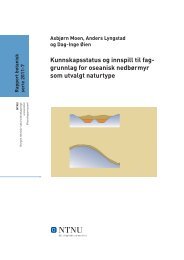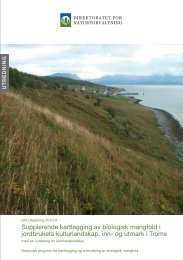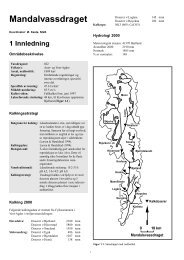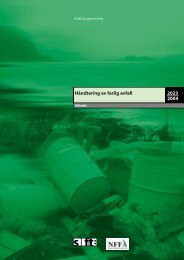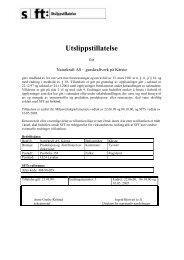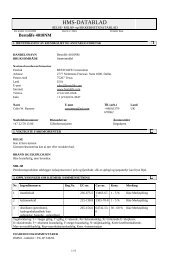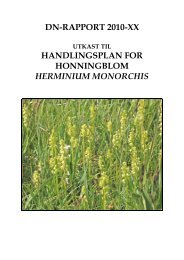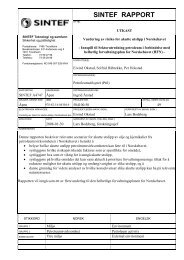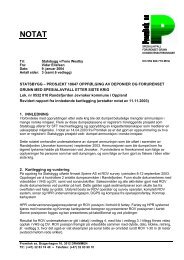Last ned - Direktoratet for naturforvaltning
Last ned - Direktoratet for naturforvaltning
Last ned - Direktoratet for naturforvaltning
You also want an ePaper? Increase the reach of your titles
YUMPU automatically turns print PDFs into web optimized ePapers that Google loves.
Klimaendringer, hav<strong>for</strong>suring og langtransportert <strong>for</strong>urensning<br />
fillet generally exceed the environmental quality standard (EQS) set by the EU. However, the<br />
pollution levels found at present have not generally been shown to have direct biological effects.<br />
It is concluded that, particularly considering the implications <strong>for</strong> food safety, long-range transport of<br />
hazardous substances currently has moderate effects in the management plan area. In the “positive”<br />
and “negative” scenarios <strong>for</strong> 2030, the effects are assessed as minor and moderate respectively.<br />
Long-range transport of marine litter affects the entire management plan area to a varying degree.<br />
Marine litter has been shown to have a number of biological effects, both externally and internally.<br />
For example, ingested litter may damage the digestive system or block the gut, preventing the<br />
ingestion of food and digestion. There is also concern about the possible effects of microplastic<br />
pollution, although relatively low concentrations were found in a study in the Skagerrak. It is likely<br />
that marine litter harms only a small proportion of many populations, but that a much larger<br />
proportion of certain seabird populations (particularly the northern fulmar) is affected. It is<br />
concluded that marine litter currently has moderate effects, and this result remains unchanged in<br />
both scenarios <strong>for</strong> 2030.<br />
Long-range transport of radioactive substances: in general, both inputs and levels of radioactive<br />
pollution are low in the North Sea and Skagerrak, but higher than in the Norwegian and Barents Seas.<br />
Current levels are well below those that have been shown to have effects on biota. The effects of this<br />
factor are there<strong>for</strong>e assessed as minor at present, and also in both scenarios <strong>for</strong> 2030. However, the<br />
“negative” scenario specifies a higher risk of acute pollution. The effects could be considerably more<br />
serious in the event of an accidental release of radioactivity.<br />
Long-range transport of nutrients and organic material. Concentrations of nutrients are generally low<br />
in the management plan area, but there are elevated concentrations in the Norwegian coastal<br />
current in the Skagerrak. The concentrations found at present probably have only minor effects in<br />
the management plan area. However, the combination of long-range transport and local inputs of<br />
nutrients along the Skagerrak coast may have effects on algal/seaweed communities used as a<br />
habitat by species that are also found in the management plan area. The assessment concludes that<br />
long-range transport of nutrients and organic material has minor effects today. In the “positive” and<br />
“negative” scenarios <strong>for</strong> 2030, the effects are assessed as minor and moderate respectively.<br />
Acute pollution: Scenarios have also been developed <strong>for</strong> a release of radioactivity from the<br />
reprocessing plant at Sellafield and an oil spill from the Preemraff oil refinery in Lysekil in Sweden.<br />
Modelling of the scenario <strong>for</strong> radioactive pollution from Sellafield indicates that there would be no<br />
effects on marine organisms, but that caesium 137 concentrations in fish and other seafood species<br />
in upper layers of the water column might <strong>for</strong> a short period of time exceed current limits.<br />
Assessment of the scenario <strong>for</strong> an oil spill from the Preemraff refinery indicates a high potential <strong>for</strong><br />
transport of oil into the management plan area. It is concluded that an oil spill would have moderate<br />
effects, but the level of uncertainty is high.<br />
Combi<strong>ned</strong> impacts<br />
There may be complex interactions between the different pressures described in this report, which<br />
makes it very difficult to predict the cumulative environmental effects. When a number of pressures<br />
Side 10 av 172



